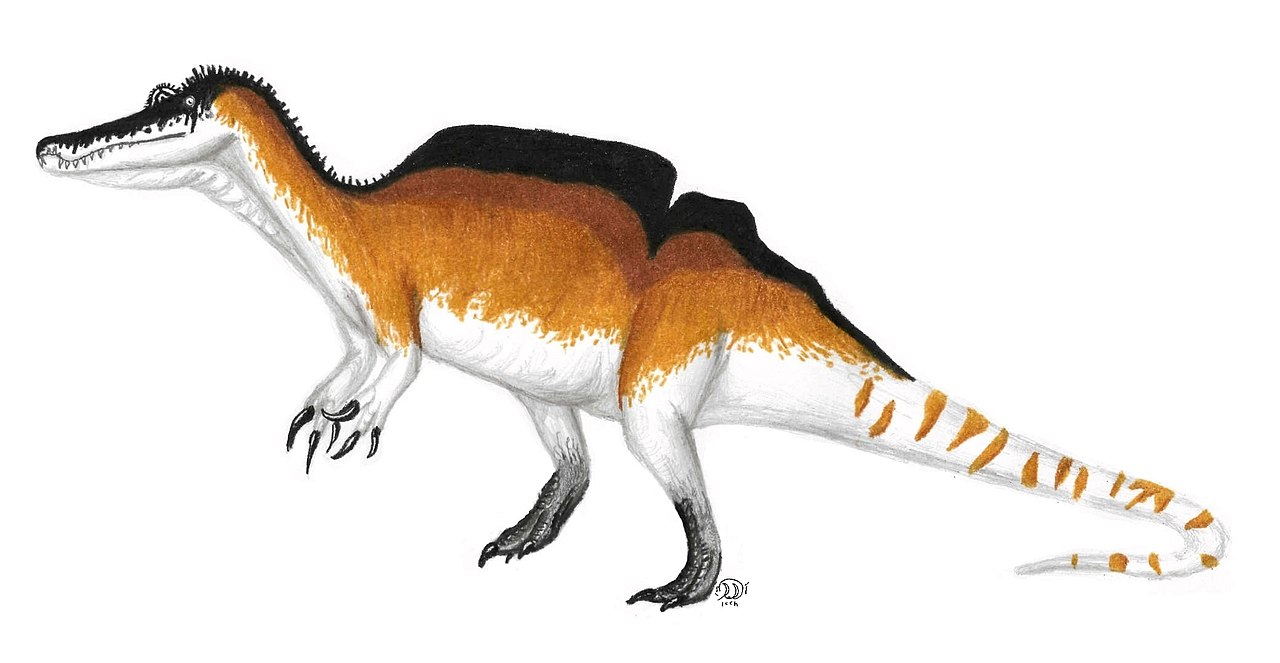Post by dinosauria101 on Aug 29, 2019 15:49:25 GMT 5
Ichthyovenator laosensis
Ichthyovenator (meaning "fish hunter") is a genus of spinosaurid theropod dinosaur that lived during the Early Cretaceous of what is now Laos, likely from the Aptian stage (113–125 million years ago). Ichthyovenator is known from fossils collected in the Grès supérieurs Formation. Like other members of its family, it had elongated neural spines forming a sail on its back, although Ichthyovenator's was unusual due to its particular wave-like curvature and being split in two over the hips. The generic name is derived from Greek ἰχθύς (ichthys), "fish", and Latin venator, "hunter", in reference to its likely piscivorous (fish-eating) lifestyle. The specific name refers to its provenance from Laos. In 2016, Gregory S. Paul estimated Ichthyovenator at 8.5 meters (27 ft) long and weighing 2 tonnes (2.2 short tons).

Bistahieversor sealeyi
Bistahieversor (meaning "Bistahi destroyer") is a genus of tyrannosaurid dinosaur. Bistahieversor existed in the Late Cretaceous Hunter Wash member of the Kirtland Formation, which has been dated to 74.55 ± 0.29 Ma. The name Bistahieversor comes from the Navajo Bistahí, or "place of the adobe formations" in reference to the Bisti/De-Na-Zin Wilderness where it was found, and eversor, meaning "destroyer. Material from both adolescent and adult individuals has been found in the Kirtland Formation of New Mexico, United States. Adult Bistahieversor are estimated to have been around 9 meters (30 ft) long, weighing at least a ton. The snout is deep, indicating that the feature is not unique to more derived tyrannosaurs such as Tyrannosaurus. Geographical barriers such as the newly forming Rocky Mountains may have isolated the more southerly Bistahieversor from more derived northern tyrannosaurs.

Credit to Wikipedia
Ichthyovenator (meaning "fish hunter") is a genus of spinosaurid theropod dinosaur that lived during the Early Cretaceous of what is now Laos, likely from the Aptian stage (113–125 million years ago). Ichthyovenator is known from fossils collected in the Grès supérieurs Formation. Like other members of its family, it had elongated neural spines forming a sail on its back, although Ichthyovenator's was unusual due to its particular wave-like curvature and being split in two over the hips. The generic name is derived from Greek ἰχθύς (ichthys), "fish", and Latin venator, "hunter", in reference to its likely piscivorous (fish-eating) lifestyle. The specific name refers to its provenance from Laos. In 2016, Gregory S. Paul estimated Ichthyovenator at 8.5 meters (27 ft) long and weighing 2 tonnes (2.2 short tons).

Bistahieversor sealeyi
Bistahieversor (meaning "Bistahi destroyer") is a genus of tyrannosaurid dinosaur. Bistahieversor existed in the Late Cretaceous Hunter Wash member of the Kirtland Formation, which has been dated to 74.55 ± 0.29 Ma. The name Bistahieversor comes from the Navajo Bistahí, or "place of the adobe formations" in reference to the Bisti/De-Na-Zin Wilderness where it was found, and eversor, meaning "destroyer. Material from both adolescent and adult individuals has been found in the Kirtland Formation of New Mexico, United States. Adult Bistahieversor are estimated to have been around 9 meters (30 ft) long, weighing at least a ton. The snout is deep, indicating that the feature is not unique to more derived tyrannosaurs such as Tyrannosaurus. Geographical barriers such as the newly forming Rocky Mountains may have isolated the more southerly Bistahieversor from more derived northern tyrannosaurs.

Credit to Wikipedia




